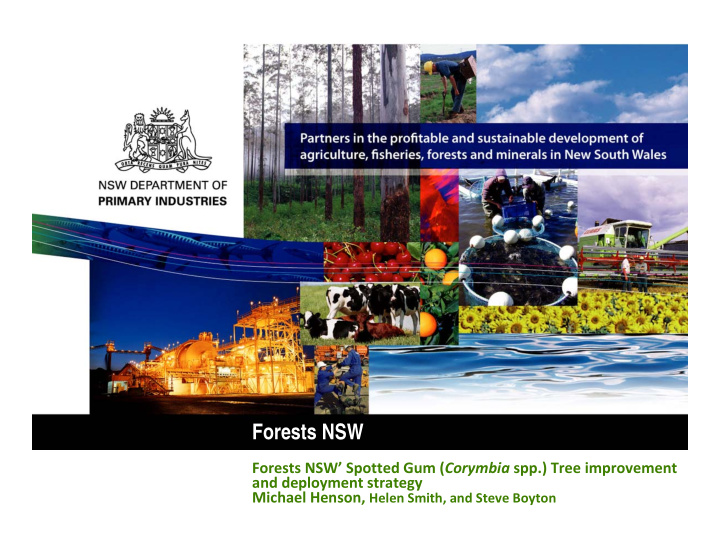



Forests NSW Forests NSW’ Spotted Gum ( Corymbia spp.) Tree improvement and deployment strategy Michael Henson, Helen Smith, and Steve Boyton
www.dpi.nsw.gov.au Corymbia Tree Improvement � Forests NSW – Corymbia Plantations � Breeding Objectives � Genetic Resources � Genetic Parameters � Additive Control of RSB � Clonal Trials � Hybrids � Deployment
www.dpi.nsw.gov.au Forests NSW 2.9 million hectares • under management 210,000 ha of P. • radiata 12,000 ha hybrid • southern pine 49,000 ha of • Eucalypt plantations
www.dpi.nsw.gov.au Spotted Gum Plantations in NSW � 8000 ha of spotted gum mainly Corymbia citroiodora subsp. Variegata established in NSW. Significant amounts of C. maculata. � Spotted Gums mainly established on poor quality low productivity sites.
www.dpi.nsw.gov.au Spotted Gums - NSW C. citriodora subsp. variegata C. henyri C. maculata
www.dpi.nsw.gov.au Spotted Gum – Queensland C. citriodora subsp. citriodora C. torrelliana
www.dpi.nsw.gov.au Breeding and Deployment Strategy � AIM: PRODUCTION OF ELITE SEED FOR SEEDLING DEPLOYMENT � Establishment of Progeny Trials � Early Health Assessments � Growth Assessment at 3 – 4 Years � Grafts Establishment in Clonal Seed Orchards � Wood Quality Assessment 10 years � Roguing of Clonal Seed Orchards � In parallel low level activity of exploring and improving vegetative propagation methods.
www.dpi.nsw.gov.au Genetic Resources Species Series Location Planted Prov Families Trees C. citriodora subsp. variegata (CCV) 1999-2001 Grafton Feb 01 17 88 1408 C. citriodora subsp. variegata 1999-2001 Casino Mar 01 16 88 2640 C. citriodora subsp. variegata 1999-2001 Casino Mar 99 38 205 4900 C. citriodora subsp. variegata 1999-2001 Casino Apr 99 1 17 550 C. citriodora subsp. variegata 2001 Quirindi Oct 01 19 120 2400 C. citriodora subsp. variegata 2004 Grafton Feb 04 60 548 6600 C. citriodora subsp. variegata 2004 Grafton Mar 04 58 528 6336 C. citriodora subsp. variegata 2004 Casino Mar 04 58 544 9792 2004 Singleton Apr 04 12 133 2800 C. maculata 2004 Casino Mar 04 12 134 2680 C. maculata 2006 Grafton Nov 06 11 98 2000 C. maculata C. citriodora subsp. citriodora () 2006 Grafton Nov 06 5 24 500 2003 Quirindi Sep 03 5 Genetic gain 1600 CCV, C. maculata 2004 Casino Apr 04 7 32 2176 CCV, C. torelliana 2006 Grafton Oct 06 80 319 6000 CCV, , C. henryi CCV, , C. maculata, C. henryi 2007 Casino Oct 07 Approx.400
www.dpi.nsw.gov.au Forests NSW – Pedigreed Trials GENETIC RESOURCES Corymbia citriodora subsp. citriodora Corymbia citriodora subsp. variegata Corymbia henyrii Corymbia maculata Corymbia torelliana
www.dpi.nsw.gov.au Breeding Objectives � Productivity – Growth � Quality – Fit for Purpose � Adaptability – Security
www.dpi.nsw.gov.au Quality � Fit for Purpose � Early Age Wood Properties � Dimensional Stability � Form � Kino production considerable risk
www.dpi.nsw.gov.au Adaptability � Frost � Ramularia Shoot Blight (RSB) – Quambalaria pitereka - MOST SIGNIFCIANT BOTTLENECK TO COMMERCIAL ESTABLISHMENT � Erinose mites (Rhombacus sp.)
www.dpi.nsw.gov.au Erinose Mite Damage
www.dpi.nsw.gov.au Genetic Control Corymbia citriodora subsp. variegata (99-01 Series) � Height @ 40 months – h 2 = 0.153 to 0.272 � RSB @ 25 months – h 2 = 0.533 (0.116) Corymbia citriodora subsp. variegata (2004 Series) � RSB @ 25 months – h 2 = 0.347 (0.076) Corymbia maculata � Height @ 23 months – h 2 = 0.421 (0.075) � RSB @ 23 months – h 2 = 0.564 (0.089)
www.dpi.nsw.gov.au RSB Tolernance Variation
www.dpi.nsw.gov.au Hybrid Development in NSW � Hybrid 2 nd Priority � Watching Brief – high risk, high cost and not proven � Evaluating Brazilian and Queensland Material – Propagation and Field Performance � Rooting similar to that of pure CCV Clones <50%and erratic. � Identification and Capture � Established 2 small hybridising orchards � Supporting genetic pollution studies and risk management plan development
www.dpi.nsw.gov.au Hybrid Benefits Risks � RSB Tolerance � Cost of Development � Frost Tolerance � Cost of Deployment on low productivity sites � Improved Growth?? � Unknown rotation age performance � Market acceptability and wood properties � Large crown (Leaf Area) on driest sites � C. torrelliana declared weed in some Shires
www.dpi.nsw.gov.au Economics of the Hybrid � Assumptions: discount rate 7%; seedling cost $0.35; rooted cutting cost $1.00 per plant; royalty $0.10 per plant; establishment 1000sph; and average timber value $35 /m 3 � 30 Year Rotation and MAI=12 m 3 /ha – require productivity increase in MAI of 4.75 m 3 /ha (40%) � 15 Year Rotation and MAI=12 m 3 /ha – require productivity increase in MAI of 3.45 m 3 /ha (29%) � More realistic will be $1.50 to $2.00 if rooting not over 80% - on 30 year rotation – 66% to 87% improvement in productivity. � Compare to CSO seed no increase in production and estimated volume gain of 40% - RSB is under strong additive control
www.dpi.nsw.gov.au CCV Clones � First Trials Established in 1997 � 2 Series of Trials Established � >25 Hectares of tested clones established in pilot plantations � Reliant on Tissue Culture � Same Problem with costs as hybrid clones � Currently used for Demonstation
www.dpi.nsw.gov.au Clonal Seed Orchards � Selections made in 1999-2001 Series of Progeny Trials � Selections based on Productivity, RSB Tolerance and Form � Significant Gains Predicted – CSO1 30% gain in volume over Woodnum (Best Prov), CSO2 40% gain in volume. � Two Clonal Seed Orchards established to date in southern NSW, third planned for establishment in Grafton � Bud production with in 18 months
www.dpi.nsw.gov.au Michael.Henson@sf.nsw.gov.au Thank You
Recommend
More recommend